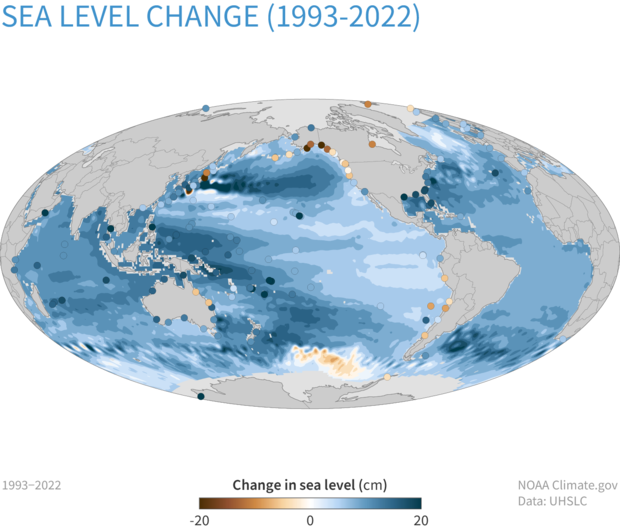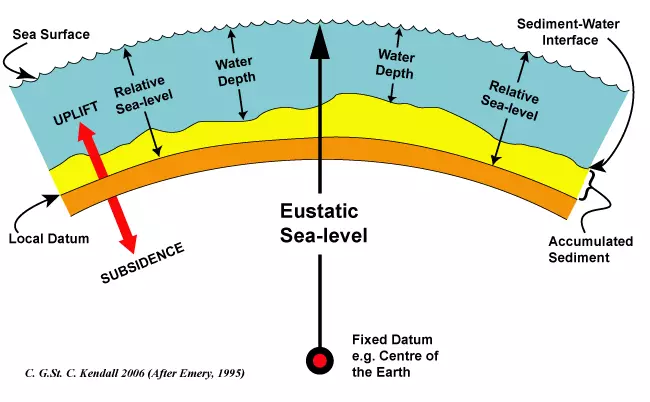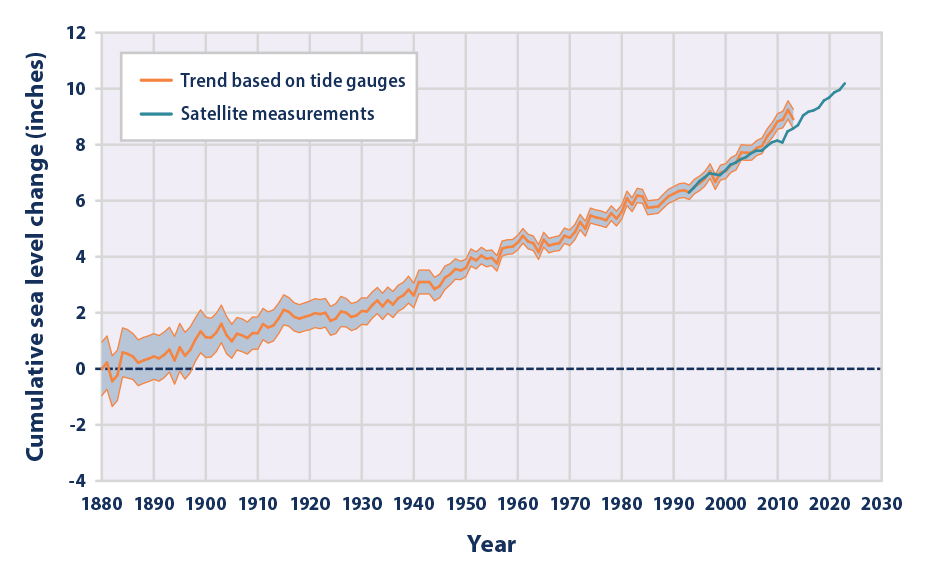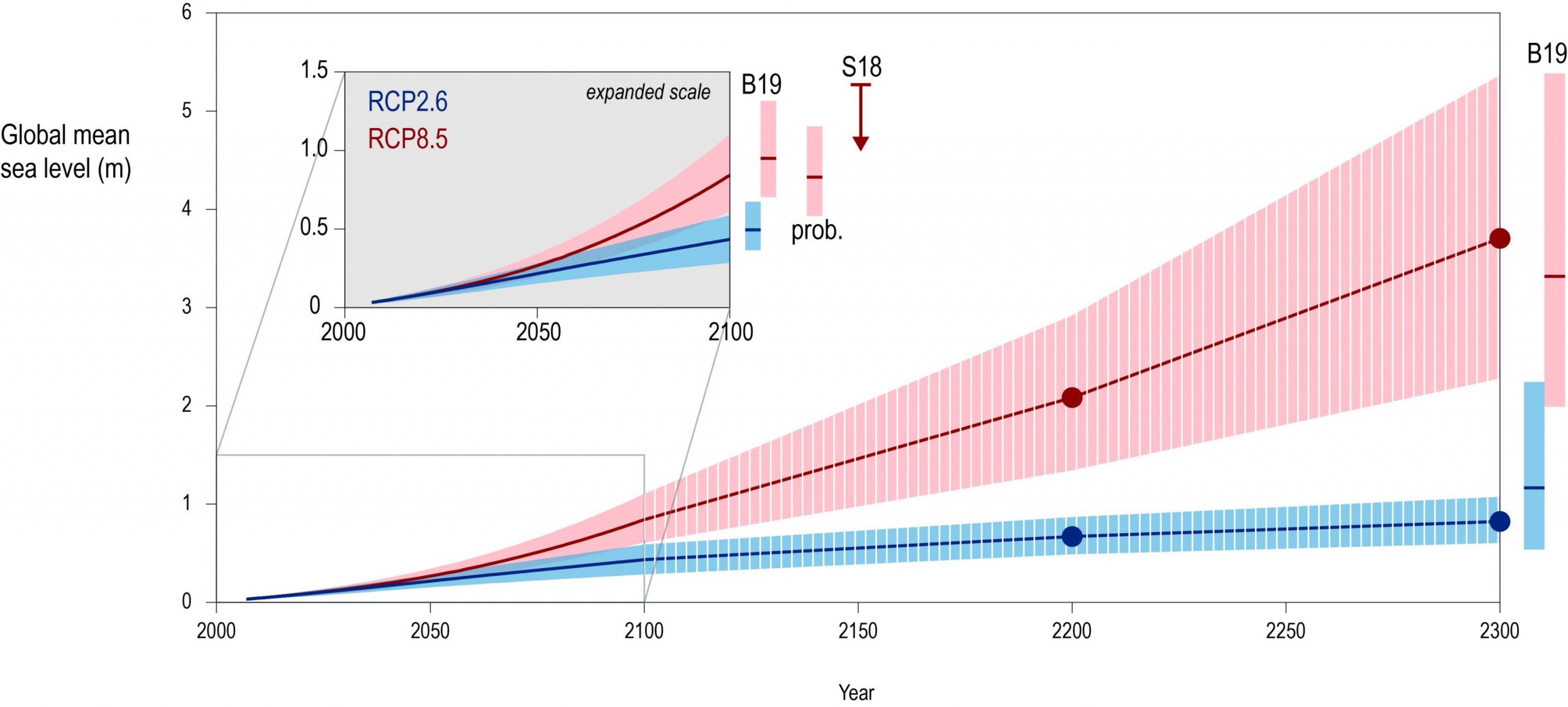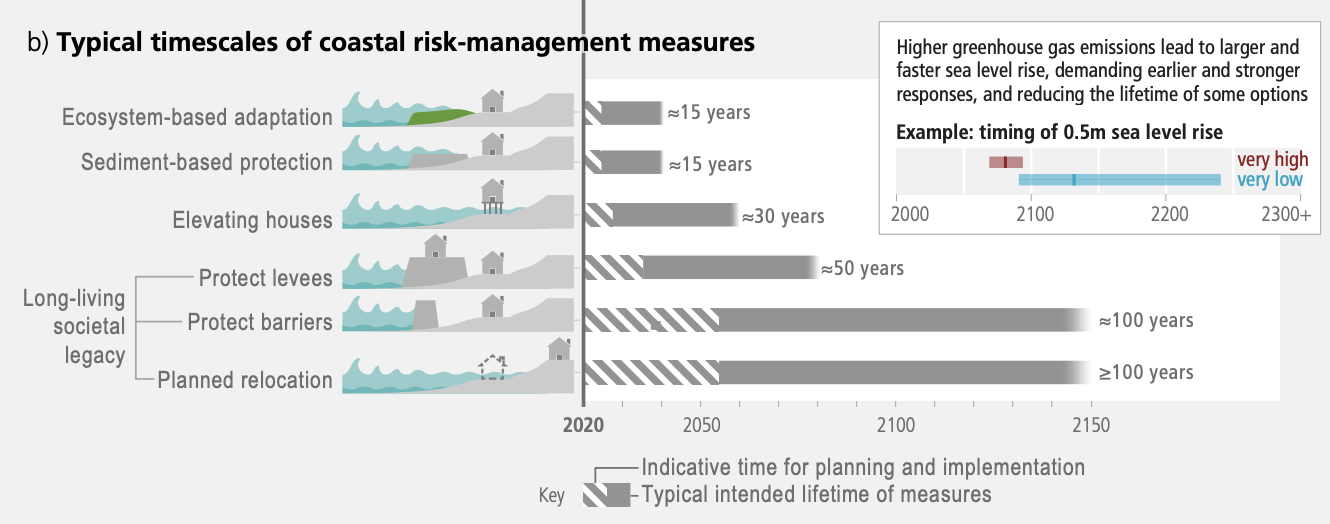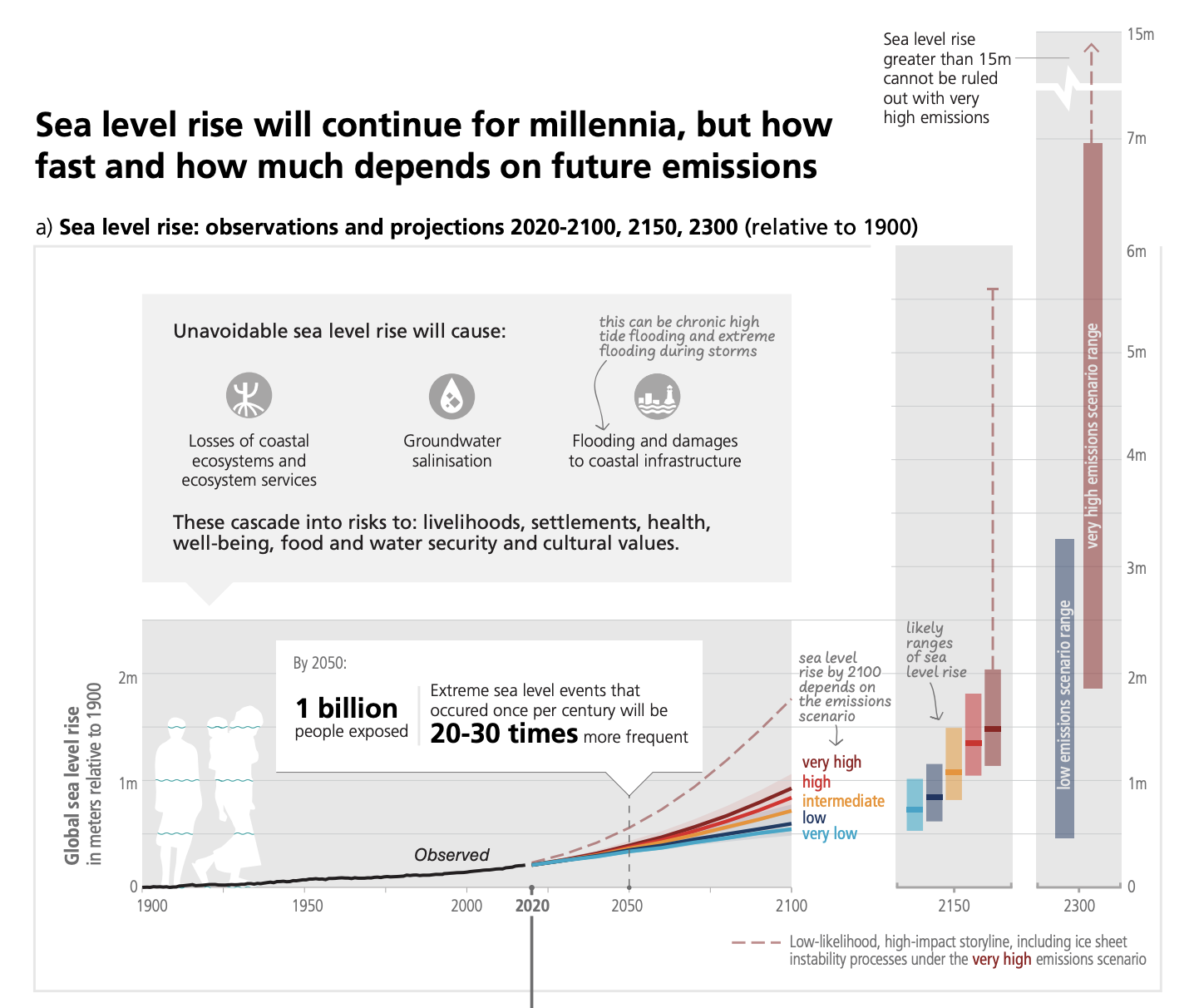
Sea-level rise: to mitigate or adapt? Experts say we need to do both.

As sea levels rise, coastal regions will face a number of negative impacts, including flooding, submerged land, and loss or changes in marine ecosystems[1]. Roughly 900 million people – or 11% of the world’s population – lived in low-lying coastal cities and settlements in 2020[2]; a figure that is projected to reach 1 billion by 2050[2]. Is there anything we can do now to reduce sea-level rise and its impacts?
Scientists explain that our past actions will already impact sea-levels for thousands of years[1], as we will detail in later sections. But not everything is set in stone. We possess the power to reduce sea-level rise and its impacts over the next century and beyond with our current actions. Some advocate to mitigate the causes, and others to adapt to the consequences. But what do experts say? In this article we will offer evidence-based insights on these subjects, and conclude with comments we received from scientific experts on these matters.
Main Takeaways:
- Global mean sea level has been rising since 1880, with evidence of acceleration;
- Greenhouse gas emissions from past human activities are projected to raise sea-levels for thousands of years;
- The primary cause of global sea-level rise since 1970 is human CO2 emissions and subsequent increases in global temperature;
- Reducing sea-level rise and its impacts requires both mitigation (i.e., reduced greenhouse gas emissions) and adaptation (e.g., building barriers);
- As sea levels rise, low-lying coastal regions will face a number of negative impacts, including flooding, submerged land, and loss or changes in marine ecosystems; and,
- Sea-level rise by the end of this century largely depends on future greenhouse gas emissions.
Key concepts and science of sea-level rise
In this section, we will cover some key concepts of sea-level rise and the scientific methods of assessing it. Sea-level rise occurs due to changes in the mass or volume of the oceans, or by physical changes in land relative to the sea surface[4]. However, because Earth and its oceans are dynamic, sea levels do not rise evenly across the planet[1,4]. As explained by NASA, two of the main factors influencing uneven sea-level rise at a regional level are ocean dynamics (i.e., redistribution of water by currents, wind, etc.) and gravity variation across Earth (because Earth’s mass is uneven). These processes cause the sea levels to rise in some regions, and drop in others, even if the overall water volume in the oceans increases (as explained in a past Science Feedback review linked here). Examples of regional and local variations are shown in Figure 1 below. Note that the vast majority of the places on Earth experienced sea-level rise, both locally and globally, with increasing levels from light to dark blue.
Figure 1 – Changes in mean sea level (large colored areas between continents – mostly blue) and local sea levels (dots of different colors) from 1993-2022. Figure source: NOAA with data from the University of Hawaii
To differentiate between global changes (i.e., eustatic) and relative changes, scientists use different terminology. Figure 2 below highlights the difference between global and regional or local changes (i.e., relative). This figure shows that global/eustatic sea-level changes are measured in relation to a fixed reference point (i.e., center of the Earth), while relative sea levels measurements use a reference point on land[4]. Because land can sink or rise, relative sea levels can change in response[4]. But why are these different types of sea level measurements helpful?
Figure 2 – Diagram showing the differences between eustatic/global sea level, relative sea levels, and their measurement reference points. Eustatic sea-level represents changes in mass or volume of Earth’s oceans, resulting in global mean sea level changes. Relative sea levels can vary according to regional changes in land characteristics, such as uplift or subsidence (e.g., rise or fall in land elevation, respectively). Source: GET Spatial Learning
Global changes inform scientists about broader climate trends (e.g., melting glaciers and ice sheets), while relative sea-level changes inform them about potential impacts at regional and local scales (e.g., land submergence). The former is measured as global mean sea level which is the average sea-level height on Earth – an important climate indicator because it provides information about ocean warming (warm water expands, raising water levels) and melting of ice, as noted earlier[1]. These are called eustatic changes, which relate to changes in the volume of water in Earth’s oceans[4]. However, as NASA explains, relative sea levels are also important: “although changes in global mean sea level (GMSL) provide an important measure of the warming climate, when assessing potential impacts at the coast, it is the change in regional relative sea level that is most important”. By monitoring both – using tidal gauge measurements and satellite data – scientists are able to study the influence of climate change on sea-level rise, and the impacts that may follow.
Sea-level changes in the past and present
Sea levels have risen and fallen throughout Earth’s history, as shown by paleoclimate studies[5]. Prior to human emissions of CO2 raising Earth’s temperatures[1] (i.e., anthropogenic forcing), natural forcings drove changes in global sea level[3]. However, “the dominant cause of GMSL [global mean sea level] rise since 1970 is anthropogenic forcing”[1], as explained by The Intergovernmental Panel on Climate Change (IPCC) – the world’s leading authority on climate science. After the Industrial Revolution, the global mean sea level rose roughly 21–24 centimeters (8-9 inches) from 1880-2020, according to NOAA (Figure 3). In 2019, the IPCC explained that rates of sea-level rise have increased over the last century in most regions[3].
Figure 3 – Global average absolute sea-level change (in inches) from 1880-2021, based on tidal gauge measurements (orange line) and recent satellite measurements (blue line). Note that ‘absolute’ sea-level change is used to represent the ocean’s surface, without regard to changes in nearby land elevation. Figure source: United States Environmental Protection Agency (EPA) with data from NOAA and CSIRO
However, prior to this, sea levels were relatively stable for a long stretch of time (i.e., nearly 3000 years) [7,8] (Figure 4). In a previous review, linked here, Science Feedback summarized scientific evidence showing that the rate of global mean sea level rise has increased compared to preceding decades or centuries. In that review, Dr. Benjamin Horton, Professor at the Earth Observatory of Singapore, provided the following comment:
“Comparison of long tide gauge records and multi-centennial to millennial scale sea-level reconstructions from the same region indicates that the rate of rise during the instrumental period (since ~1850 CE) was significantly faster than it was during the late Holocene (the 4000–2000 years prior to ~1850 CE). The data demonstrate that an acceleration in the rate of sea-level rise occurred[8].”
Figure 4 – Long-term global mean sea level change for the past 20,000 years (black line) based on paleo sea-level records and projections for the next 10,000 years for four emission scenarios. The x-axis represents years before (-) or after (+) present. The smaller plot along the x-axis is sea-level change in meters per 100 years. Adapted from the following source: Clark et al. (2016)[7]
In another Science Feedback review, Horton shared insights about sea-level rise in the deeper past, and what has driven recent increases in global sea level rise:
“Without global warming, global sea level would have risen by less than half the observed 20th century increase and might even have fallen. We published another paper in PNAS (Kopp et al., 2016[8]) that showed that with global warming global sea level rose by about 14 centimeters, or 5.5 inches, from 1900 to 2000. That is a substantial increase, especially for vulnerable, low-lying coastal areas. The sinking of land in Virginia is responsible for the slow sea-level rise from 3000 years ago to the beginning of the industrial revolution. The 20th century rise was extraordinary in the context of the last three millennia—and the rise over the last two decades has been even faster. The study’s global sea-level reconstruction calculated how temperatures relate to the rate of sea-level change. Based on this relationship, the study found that, without global warming, 20th century global sea-level change would very likely have been between a decrease of 3 centimeters (1.2 inches) and a rise of 7 centimeters (2.8 inches). A companion report finds that, without the global warming-induced component of sea-level rise, more than half of the 8,000 coastal nuisance floods observed at studied US tide gauge sites since 1950 would not have occurred.”
For this article, we asked Dr. Peter Gleick, President-emeritus and Senior Fellow at the Pacific Institute, about current sea-level rise and its impacts, to which he responded:
“Scientific evidence is extremely clear: sea levels have gone up substantially over the past century, as a result of human-caused climate change, and the rates of increase are accelerating. The causes are primarily thermal expansion as global temperatures rise (warm water takes up more space than cold water) and the rapid melting of land-based ice in Greenland, Antarctica, and mountain glaciers, which increases the total volume of water in the oceans. These recorded increases in sea-level mean that storms that cause flooding are more damaging than they would otherwise be.[9]”
Storm surges are abnormal water level rises that occur during storms, which can cause extreme flooding in coastal areas, according to NOAA. A recent example in the video linked here, and shown in a screen shot in Figure 5, shows a storm surge and widespread flooding in Surfside, Texas, after Tropical Storm Alberto on 19 June 2024.
Figure 5 – Storm surge and widespread flooding in Surfside, Texas, after Tropical Storm Alberto on 19 June 2024. Source: WXChasing
The effects of sea-level rise on these types of flooding events are well summarized by Horton in his comment to Science Feedback:
“Sea-level rise contributes significantly to the frequency of flooding from hurricanes. The contribution from sea-level rise to flood height works in together with other factors such as timing of the storm relative to high tide, and the strength and direction of individual hurricanes. Sea-level rise between hurricanes raises the “baseline” water level and makes flooding more likely.”
In fact, the IPCC explains that “even a small increase in mean sea level can significantly augment the frequency and intensity of flooding”[3] and that the combination of extreme sea-level events – such as tides, surges, and waves – and gradual sea-level rise cause coastal impacts. For example, a study by Strauss et al. (2021) explains that approximately 8.1 billion dollars in damages done by Hurricane Sandy in 2012 is attributable to anthropogenic sea-level rise[10]. In the next section we will discuss how sea levels are expected to rise over the next century and beyond, and what impacts are anticipated.
Projected sea-level rise and impacts: 2050, 2100, and beyond
Earlier we mentioned that the number of people living in low-lying coastal areas is projected to increase from 900 million people – as of 2020 – to 1 billion by the year 2050[2]. But what sea-level changes and impacts do we expect to face by then?
The IPCC explains that “up to 2050, uncertainty in climate change-driven future sea level is relatively small”[3]. They also explain that extreme sea levels that have been historically rare will likely be experienced annually by 2050 in many low-lying cities and small islands, and will become common by 2100 due to projected global mean sea level rise[3]. To predict future sea-level rise, scientists model different global mean sea level scenarios by simulating the physical processes that affect sea levels[6]. This process involves using Representative Concentration Pathways (RCPs), which are different trajectories of greenhouse gas emissions and concentrations, and other variables like land cover[3]. These models project that by 2050, global mean sea level will rise between 0.24 meters (low greenhouse gas emission trajectory) and 0.32 meters (high greenhouse gas emission trajectory)[3] (Figure 6). However, as the century progresses, the difference in sea-level rise between low-emission and high-emission scenarios grows.
Figure 6 – Projected sea-level rise until 2300. The inset (small box) shows the likely range of the global mean sea level projections for emission scenarios RCP2.6 (blue) and RCP8.5 (pink) up to the year 2100. RCP2.6 is a low-emission scenario, and RCP8.5 is a high emission scenario. Note that uncertainty is low up to the year 2050. Source: IPCC (2019)[3]
Models project that by 2100, global mean sea level will rise between 0.43 meters (under the low emission trajectory) and 0.84 meters (under the high-emission trajectory)[3]. However, as explained by the IPCC – and reflected in Figure 6 – “beyond 2050, uncertainty in climate change induced SLR [sea-level rise] increases substantially due to uncertainties in emission scenarios and the associated climate changes, and the response of the AIS [Antarctic Ice Sheet] in a warmer world”[3]. In other words, scientists cannot entirely predict how much greenhouse gas will be emitted over that time period. As we approach 2100 and beyond, the sea-level rise outcomes strongly diverge under low- and high-emission scenarios.
However, regardless of the emission trajectory that is followed, scientists have high confidence about certain impacts. For example, IPCC explains that under all projected emission scenarios (i.e., RCPs), extreme sea-level events that were historically rare will become common by 2100 due to projected global sea level rise[3]. The resulting impacts will most strongly affect low-lying coastal areas and will result in severe flooding[3]. We also expect to see these impacts in the near term, with many low-lying coastal regions experiencing these events annually by 2050[3]. The severity of these impacts will depend, in part, on human activities and interventions over the coming century. So what can be done to reduce them?
Sea-level rise: adaptation and mitigation
There are two main approaches to addressing sea-level rise and its impacts: adaptation and mitigation. Adaptation involves adjusting to current and future changes, while mitigation aims to reduce changes. For sea-level rise, examples of adaptation measures include building sea walls, modifying zoning laws, ecological restoration, etc.[3]. Whereas, mitigation involves reducing things – such as greenhouse gas emissions – that are known to increase sea-level rise[3].
Climate scientists explain that it is important, and even critical, to use both adaptation and mitigation to address current and future sea-level rise. For example, the IPCC explains that their “assessment of the ocean and cryosphere in a changing climate reveals the benefits of ambitious mitigation and effective adaptation for sustainable development and, conversely, the escalating costs and risks of delayed action”[3]. We asked relevant scientific experts about the importance of adaptation and mitigation, and they said the following:
Ella Gilbert, Research Scientist, British Antarctic Survey:
“mitigating emissions is still of paramount importance. At the same time, it is essential to plan accordingly for a future that will look very different, so adaptation must happen alongside emissions reductions efforts. There is no either-or choice in this; both are required.”
Peter Gleick, President Emeritus and Chief Scientist, Pacific Institute:
“We no longer have the luxury of doing “one or the other.” We now live in a world with rapid, unprecedented climate change, and we must both accelerate efforts to reduce the drivers of climate change by cutting carbon emissions and we must accelerate efforts to adapt to those impacts we can no longer avoid, including rising sea levels.”
Robert Kopp, Distinguished Professor, Rutgers University:
“it is not enough to just mitigate or just adapt – without mitigation, global average sea level could rise at a pace that is essentially impossible to adapt to, while adaptation is already a present-day necessity”
An important aspect of planning is understanding the time frame in which sea levels – and the variables that affect them – respond to climate change. For example, certain variables (e.g., glacier melt) that raise sea levels respond slowly to changing conditions[3]. There is ‘inertia’ in Earth’s climate system, and even after greenhouse gases (e.g., CO2) emissions are decreased, global temperatures respond slowly, and thus continue to rise[11]. As a result, past human greenhouse gas emissions will lead to future sea-level rise even if emissions are reduced[3,6,12]. Scientists describe this as ‘committed’ sea-level change. As the IPCC explains:
“Sea level at the end of the century will be higher than present day and continuing to rise in all cases even if the Paris Agreement is followed[12] . . . the reasons for this are mainly related to the slow response of glacier melt, thermal expansion and ice sheet mass loss[12] . . . these processes operate on long time scales, implying that even if the rise in global temperature slows or the trend reverses, sea level will continue to rise”[3].
Despite committed levels of sea-level rise in the long term (i.e., thousands of years)[1], there are things that can be done to reduce sea-level rise and impacts over the next century. In fact, the IPCC explains that it is important to start adaptation measures early because they often have long planning and implementation times[13]. Examples of sea-level rise adaptations and their timescales for coastal risk management are shown in Figure 7.
Figure 7 – The right half of the figure lists the typical time scales of adaptation measures, including planning, implementation, and intended lifetime. The left half of the figure shows illustrated examples of the listed adaptation measures. Source: IPCC (2023)[13]
However, adaptation alone is insufficient, as explained above in comments we received from experts in climate science and oceanography. In addition, the IPCC explains that “adaptation options that are feasible and effective today will become constrained and less effective with increasing global warming”[13]. One reason for this is that coastal protection becomes more challenging as sea-levels rise, “mainly due to economic, financial and social barriers”[3]. Thus, the addition of mitigation measures – which can reduce sea-level rise and its impacts – expands adaptation opportunities. The IPCC explains that “deep, rapid, and sustained GHG [greenhouse gas] emissions reductions would limit further sea-level rise acceleration and projected long-term sea-level rise commitment”[13] (Figure 8).
Figure 8 – Sea-level rise observations and projections based on different emission scenarios. The figure also includes information on impacts associated with unavoidable sea-level rise (i.e. committed sea-level rise based on present conditions). Source: IPCC (2023)[13]
Conclusion
Global mean sea level has been rising since 1880 and with evidence of acceleration. Human CO2 emissions and subsequent global temperature increases (i.e., anthropogenic forcing) is the primary cause of global mean sea level rise since 1970. These emissions lead to warming of our oceans and atmosphere, causing melting and loss of ice sheets and thermal expansion of the ocean – both of which raise global sea levels. Based on current climate conditions – e.g., atmospheric greenhouse gas concentrations – there is a certain amount of unavoidable sea-level rise in the long term (e.g., over thousands of years) due to inertia in Earth’s climate system. Climate scientists have greater certainty about expected sea-level rise by 2050. However, sea-level rise outcomes strongly diverge as we approach 2100 and beyond based on greenhouse gas emission scenarios and other climate variables. The impacts of sea-level rise – which will most strongly affect humans and ecosystems in low-lying coastal areas – can be reduced through mitigation and adaptation. Mitigation involves reducing greenhouse gas emissions to reduce global warming and downstream climate effects. Adaptation involves adjusting to current and future effects of sea-level rise by using engineered structures and societal changes. Climate scientists explain that both strategies are needed to reduce the impacts of future sea-level rise.
SCIENTISTS’ FEEDBACK
To gain deeper insights on sea-level rise and its impacts, we asked scientists with relevant expertise the following questions, and included their responses below:
- In terms of reducing impacts of sea-level rise to coastal regions, what does the evidence show regarding the importance of adaptation vs. reducing main drivers (i.e., anthropogenic forcing via CO2 emissions)? Is it enough to do one or the other?
- What does scientific evidence show regarding current sea-level rise and its impacts? Are there impacts that can be attributed to anthropogenic climate change?
- What negative impacts do we anticipate in the future based on likely scenarios of sea-level rise?
Ella Gilbert, Research Scientist, British Antarctic Survey:
The IPCC notes that sea level rise of greater than 15m by 2300 cannot be ruled out – this kind of sea level rise would be associated with tipping points, particularly in the Greenland and West Antarctic ice sheets. IMBIE estimates[14] show that sea levels rose by 21.0±1.9 mm from 1992-2020 as a result of ice mass loss from Greenland and Antarctica, and the IPCC shows that even warming of 1.5 degrees –a target that we will surely exceed at current rates of emissions– will unavoidably result in sea level rise of at least 2m over the next 2000 years, and 6m over the much longer term[1]. In other words, we will inevitably see many metres of sea level rise as a result of human actions to-date. Many more metres of sea level rise could result from crossing ice sheet tipping points. For example, new research[15-17] shows that sea level rise may be higher than anticipated and that exceeding tipping points in the West Antarctic is likely inevitable. This would result in up to 3.3m of sea level rise over the coming centuries. Meanwhile, the loss of the Greenland ice sheet would result in up to 7m of sea level rise. Scientists think the threshold for tipping the West Antarctic and Greenland ice sheets is probably somewhere around 1.5 degrees of global mean warming[18].
Sea level rise is related to human emissions of greenhouse gases, which warm the oceans and atmosphere, driving mass loss from ice sheets and the thermal expansion of the ocean[e.g. 19,1]. While we are now inevitably committed to several metres of sea level rise, the timing of this depends on emissions and the rate of future warming. Therefore, mitigating emissions is still of paramount importance. At the same time, it is essential to plan accordingly for a future that will look very different, so adaptation must happen alongside emissions reductions efforts. There is no either-or choice in this; both are required. Rising sea levels will reshape coastlines: many of the world’s major cities are near coasts and will have to invest in considerable protection measures or relocate. However, given the long lead times on significant sea level rise, we have time to implement adaptation plans. For example, Le Cozannet et al. (2023) highlight the need to adapt to 2 m of sea level rise immediately[19] –although in my view it would be prudent to include plans to adapt to much higher levels of sea level rise in the long term.
Peter Gleick, President Emeritus and Chief Scientist, Pacific Institute:
- We no longer have the luxury of doing “one or the other.” We now live in a world with rapid, unprecedented climate change, and we must both accelerate efforts to reduce the drivers of climate change by cutting carbon emissions and we must accelerate efforts to adapt to those impacts we can no longer avoid, including rising sea levels.
- Scientific evidence is extremely clear: sea levels have gone up substantially over the past century, as a result of human-caused climate change, and the rates of increase are accelerating. The causes are primarily thermal expansion as global temperatures rise (warm water takes up more space than cold water) and the rapid melting of land-based ice in Greenland, Antarctica, and mountain glaciers, which increases the total volume of water in the oceans. These recorded increases in sea-level mean that storms that cause flooding are more damaging than they would otherwise be.
- The impacts of sea-level rise include coastal flooding and damages to coastal infrastructure, loss of life during storms, destruction of delicate freshwater/saltwater coastal ecosystems, massive population dislocations in low-lying areas, massive destruction of low-lying homes and industry, and much more.
Sources:
- Hauer et al. (2020). Sea-level rise and human migration. Nature Reviews Earth & Environment.[9]
- Horton et al. (2020). Estimating global mean sea-level rise and its uncertainties by 2100 and 2300 from an expert survey. Nature Partner Journals Climate and Atmospheric Science.[20]
- Siegert et al. (2020). Twenty-first century sea-level rise could exceed IPCC projections for strong-warming futures. One Earth.[21]
- Because the oceans and ice sheets respond slowly to a warming climate, sea-level rise for the next quarter century is largely locked in. As the IPCC Sixth Assessment Report concluded, it is likely that, by 2050, global average sea level will be between 0.15 and 0.29 m [meters] (0.5-1.0’ [feet]) higher than at the beginning of the century, with only modest variation in the range (0.05 m, or about 2 inches) driven by the sweep of possible future emissions trajectory[1]. Thus, there is a substantial amount of sea-level rise that *must* be adapted to, regardless of the success of climate change mitigation. As we go later into the century, changes in emissions play an increasingly large role in the range of future sea-level rise. Under a very low emissions trajectory, consistent with the most ambitious Paris Agreement goals (SSP1-1.9), global average sea level by 2100 will likely be 0.28-0.55 m (1-2 feet) higher than at the beginning of the century[1]. Under a high emissions trajectory consistent with the failure of global climate policy (SSP3-7), global average sea level by 2100 will likely be 0.55-0.90 m (2-3 feet) higher than at the beginning of the century[1]. These differences continue to grow beyond 2100, reaching 0.4-0.9 m (1-3 feet) vs. 0.9-1.7 m (3-5 feet) by 2150[1]. What’s more, these numbers do not include the possibility of rapid ice sheet collapse, a hard-to-quantify danger that becomes increasingly plausible with greater emissions. As the IPCC concluded, under very high emissions, the possibility of rapid ice sheet collapse means global average sea level rise approaching 2 m (7 feet) by 2100 and 5 m (15 feet) by 2150 cannot be ruled out[1]. Thus, it is not enough to just mitigate or just adapt – without mitigation, global average sea level could rise at a pace that is essentially impossible to adapt to, while adaptation is already a present-day necessity.
- Global average sea level rise since 1900 (about 0.2 m or 0.7 feet from 1900-2018) was faster than during any century in at least three thousand years[1]. Rising seas are making storm-related floods more common, extensive, and expensive, and are also increasing the frequency of tidal flooding. On average around the world, high-tide flooding events became about 50% more common from 1970 to 2005[1]. On the Jersey Shore, we see more than a week per year of coastal flooding that would have been considered a 1-in-2 year event in the 1950s; a majority of this increase is due to the factors driving global average sea-level rise. Anthropogenic climate change has been the main driver of global average sea-level rise over the last half century[1].
- Future sea-level rise will cause these trends to continue. For example, by 2050, extreme sea-level events that were considered a 1-in-100 year event in the recent past will become annual events at more than 20% of tide gauges by the middle of the century, and around the world will become 20-30 times more common on average[1]. Here in New Jersey, tidal flooding along the Jersey Shore is expected to grow from 5 days/year on average at the beginning of the century to 45-255 days/year by 2050, and become the new normal by the end of the century, and similar effects will be seen around the world. All the statements above are from the IPCC Sixth Assessment Report Working Group 1 report[1], with the exception of those specific to New Jersey, which come from the 2019 NJ Science and Technical Advisory Panel report on sea-level rise.
REFERENCES
EIN Presswire does not exercise editorial control over third-party content provided, uploaded, published, or distributed by users of EIN Presswire. We are a distributor, not a publisher, of 3rd party content. Such content may contain the views, opinions, statements, offers, and other material of the respective users, suppliers, participants, or authors.

